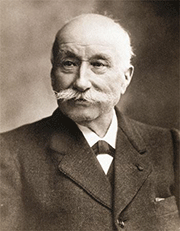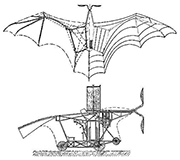E-Archive
Off the Beaten Track
in Vol. 20 - March Issue - Year 2019
The God Of The Winds

Clément Ader

The Éole patent drawing
Clément Ader was a French engineer born in 1841. He joined a railroad company after finishing school, but his inquisitive and restless mind felt trapped in his boring job and he quit four years later. His next job at the ministry in charge of transportation and communications was not much better, but at least it afforded him time to pursue his interests in the fields of electricity and mechanics. By the age of twenty-five, Clément had already filed his first patents. One of his earliest inventions was his “rubber bicycle”, for which he patented a method to coat the iron wheels with a layer of rubber, thus ensuring a much smoother ride. During the Franco-Prussian War of 1870-1871, Ader built a balloon at his own expense and by 1873, he began building and experimenting with gliders. During this time he also experimented with a flapping wing machine and made many drawings and calculations tackling various problems related to manned flight.
In 1876, Ader left his job in order to dedicate himself to the study of aeronautics, which had become his full-time passion. In 1882 he began work on a fixed-wing, self-powered aircraft. Based on studies by French ornithologist Louis Mouillard, Ader designed a tailless airplane with foldable wings resembling those of a bat. With a wooden frame and cloth covering, it was 6.5 m long and had a 14 m wingspan. The entire aircraft weighed less than 300 kg and total wing area was 28 m2, although there were no controlling surfaces. Realizing that engines available at that time had insufficient power-to-weight ratios, Clément designed and built his own lightweight four-cylinder steam engine weighing slightly more than 60 kg and capable of generating 15 kW (20 hp); the engine being mounted on a four-bladed tractor propeller. In April 1890, Ader was granted a patent for his aircraft, which he named Éole, after the Greek god of the winds, Aeolus.
On October 9th 1890, Ader pushed the throttle forward and the Éole slowly rolled down the grassy field. Reaching its top speed of 58 km/h, the aircraft flew for about 50 meters at a height of about 20 cm, getting just enough lift from the wing in ground effect. Although Éole was incapable of either sustained or controlled flight, some aviation historians consider this as having been the first flight, since it was the first time that a powered aircraft carrying a human being took off from level ground.
Buoyed by this success, Ader immediately began designing a second aircraft, to be named Avion II, but he quickly abandoned this project when the French War Office offered to fund research on a bigger and more powerful aircraft. Ader called this new airplane Avion III. The new design maintained the bat-like wing structure of the Éole, but it had a 15 m wingspan and it was equipped with two 30 hp steam engines, each mounting a four-bladed tractor propeller. A test flight in October 1897 was not very successful, and the French military withdrew its financial support, effectively forcing Ader to abandon his work. The original Avion III is now on display at a museum in Paris.
Although frustrated in his attempts to build a viable aircraft, Ader continued to study various aeronautical matters and in 1909, published a highly-popular book entitled L'Aviation Militaire. In this book, which went through ten editions, Ader discusses aerial warfare and also proposes the design for a revolutionary type of warship that would become the modern aircraft carrier. His proposal came to the attention of the US Navy, which quickly acted upon his ideas and began trial runs in November 1910.
Known primarily for his work in the field of aviation, Ader was also a successful electrical and mechanical engineer. He improved on the original telephone design by Alexander Graham Bell, and he installed the first telephone network in Paris in 1880. The following year, he invented the théâtrophone, a stereophonic sound system for theater audiences that allowed him to earn a fortune.
In 1900, Clément Ader founded an automobile industry that became famous for its innovative engine designs. Production started with V2 and V4 engines and eventually moved up to V8 engines. In 1902, the company started developing race cars that attracted considerable attention around Europe, especially during the Paris to Madrid road race in 1903.
By Giovanni Gregorat, Contributing Editor MFN



























